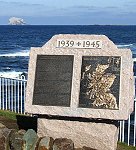 |
| Coastal Command Scottish Memorial |
 The vital part played by Scotland in supporting the maritime air campaign, providing both air and ground crews and the forward bases essential for conducting the air war in the Atlantic and the Northern Oceans, justifies a Tribute specific to Scotland.
This Tribute commemorates that role, and the memory of those who gave their lives whilst operating from Scotland. The vital part played by Scotland in supporting the maritime air campaign, providing both air and ground crews and the forward bases essential for conducting the air war in the Atlantic and the Northern Oceans, justifies a Tribute specific to Scotland.
This Tribute commemorates that role, and the memory of those who gave their lives whilst operating from Scotland.The location at the Scottish Seabird Centre was chosen because of its impressive views over the sea – Coastal Command’s Theatre of Operations, and because it receives over forty thousand visitors of all ages each year, ensuring that the Tribute, and what it represents, will be seen by current and future generations. The Memorial was designed by the Commonwealth War Graves Commission and takes the form of a block of pink Scottish granite, crafted in Aberdeen, on which are located 2 bronze plaques – one a map of the 27 Scottish Maritime bases in use during the Second World war, and the second the legend attached below. It was unveiled by John Cruickshank VC on 4th May 2007 at the Scottish Seabird Centre, North Berwick. Almost 11,000 maritime aircrew died during the War, and their names are recorded in a Book of Remembrance, funded by the late Squadron Leader Tony Spooner DSO DFC. The Sacred Volume of this Book is held in Westminster Abbey and a copy was presented during the Ceremony to Sir John Swinton, Chairman of the Scottish National War Memorial, for retention in the Library of the Memorial Chapel in Edinburgh Castle. A short Service of Commemoration is held at the Tribute on the first Sunday in May – the day traditionally set aside to mark victory over the U-Boat threat in 1943 and known as “Battle of the Atlantic Sunday” – the next event taking place on 2nd May 2010. |
|
Text on the Memorial |
|
TRIBUTE TO ROYAL AIR FORCE COASTAL COMMAND IN SCOTLAND |
| During the Second World War, aircraft of Royal Air Force Coastal Command operated from the 27 Scottish bases depicted on this map display under control from a headquarters at Pitreavie Castle in Fife. The British Isles presented a physical barrier to the submarines and ships of the German Navy, around which they had to navigate before they could operate against Britain’s vital shipping lifelines across the Atlantic Ocean. The first task of the maritime and photo reconnaissance squadrons, operating from these bases, was therefore to search for and attack enemy submarines and warships attempting to sail around the north of Scotland or through the Faeroes-Iceland gap. Patrols from bases on the East Coast also swept out across the North Sea towards the coasts of Norway and Denmark on reconnaissance and anti-shipping strikes in the face of fierce opposition against German convoys sailing down the Norwegian coast. Others, took off from the West Coast and flew far out into the Atlantic constantly searching for U-boats and raiders deployed to attack our convoys carrying food, war materials and men to Britain from Canada and the United States. German naval units were also based in Norway, following the occupation of that country, making the tasks of Coastal Command yet more difficult with its aircraft operating over the inhospitable waters of the far north, to stop the U-boats reaching the Atlantic and also to support our convoys sailing to Russia round the north of Norway. Among other roles, the meteorological squadrons, operating at long range over the Atlantic in all weathers, were pivotal to the success of Bomber Command and in preparing for the Allied landings in Normandy in 1944. While the Air Sea Rescue launches, deployed around the Scottish coastline, played their crucial part in the rescue from the sea of airmen and seamen, both friend and foe. In their long and demanding patrols across the featureless expanse of the ocean searching for the enemy, the crews of Coastal Command faced danger not only from enemy attack, but also from extreme weather. In contributing to the Command’s overall task, and its magnificent record of 189 submarines sunk and a million tons of enemy shipping sunk or disabled, many made the supreme sacrifice. But by their courage and perseverance - as for those of a later Cold War age - they helped preserve the freedoms we now enjoy. |